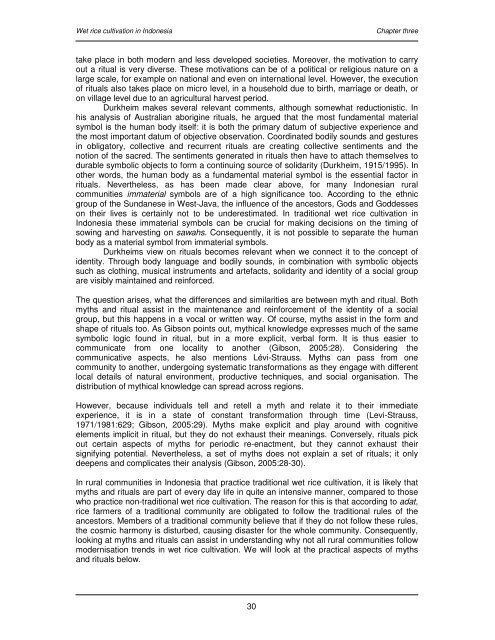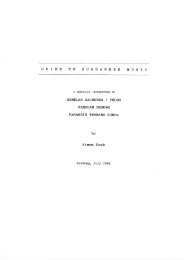Wet rice cultivation in Indonesia - Free EBooks Library
Wet rice cultivation in Indonesia - Free EBooks Library
Wet rice cultivation in Indonesia - Free EBooks Library
Create successful ePaper yourself
Turn your PDF publications into a flip-book with our unique Google optimized e-Paper software.
<strong>Wet</strong> <strong>rice</strong> <strong>cultivation</strong> <strong>in</strong> <strong>Indonesia</strong> Chapter three<br />
take place <strong>in</strong> both modern and less developed societies. Moreover, the motivation to carry<br />
out a ritual is very diverse. These motivations can be of a political or religious nature on a<br />
large scale, for example on national and even on <strong>in</strong>ternational level. However, the execution<br />
of rituals also takes place on micro level, <strong>in</strong> a household due to birth, marriage or death, or<br />
on village level due to an agricultural harvest period.<br />
Durkheim makes several relevant comments, although somewhat reductionistic. In<br />
his analysis of Australian aborig<strong>in</strong>e rituals, he argued that the most fundamental material<br />
symbol is the human body itself: it is both the primary datum of subjective experience and<br />
the most important datum of objective observation. Coord<strong>in</strong>ated bodily sounds and gestures<br />
<strong>in</strong> obligatory, collective and recurrent rituals are creat<strong>in</strong>g collective sentiments and the<br />
notion of the sacred. The sentiments generated <strong>in</strong> rituals then have to attach themselves to<br />
durable symbolic objects to form a cont<strong>in</strong>u<strong>in</strong>g source of solidarity (Durkheim, 1915/1995). In<br />
other words, the human body as a fundamental material symbol is the essential factor <strong>in</strong><br />
rituals. Nevertheless, as has been made clear above, for many <strong>Indonesia</strong>n rural<br />
communities immaterial symbols are of a high significance too. Accord<strong>in</strong>g to the ethnic<br />
group of the Sundanese <strong>in</strong> West-Java, the <strong>in</strong>fluence of the ancestors, Gods and Goddesses<br />
on their lives is certa<strong>in</strong>ly not to be underestimated. In traditional wet <strong>rice</strong> <strong>cultivation</strong> <strong>in</strong><br />
<strong>Indonesia</strong> these immaterial symbols can be crucial for mak<strong>in</strong>g decisions on the tim<strong>in</strong>g of<br />
sow<strong>in</strong>g and harvest<strong>in</strong>g on sawahs. Consequently, it is not possible to separate the human<br />
body as a material symbol from immaterial symbols.<br />
Durkheims view on rituals becomes relevant when we connect it to the concept of<br />
identity. Through body language and bodily sounds, <strong>in</strong> comb<strong>in</strong>ation with symbolic objects<br />
such as cloth<strong>in</strong>g, musical <strong>in</strong>struments and artefacts, solidarity and identity of a social group<br />
are visibly ma<strong>in</strong>ta<strong>in</strong>ed and re<strong>in</strong>forced.<br />
The question arises, what the differences and similarities are between myth and ritual. Both<br />
myths and ritual assist <strong>in</strong> the ma<strong>in</strong>tenance and re<strong>in</strong>forcement of the identity of a social<br />
group, but this happens <strong>in</strong> a vocal or written way. Of course, myths assist <strong>in</strong> the form and<br />
shape of rituals too. As Gibson po<strong>in</strong>ts out, mythical knowledge expresses much of the same<br />
symbolic logic found <strong>in</strong> ritual, but <strong>in</strong> a more explicit, verbal form. It is thus easier to<br />
communicate from one locality to another (Gibson, 2005:28). Consider<strong>in</strong>g the<br />
communicative aspects, he also mentions Lévi-Strauss. Myths can pass from one<br />
community to another, undergo<strong>in</strong>g systematic transformations as they engage with different<br />
local details of natural environment, productive techniques, and social organisation. The<br />
distribution of mythical knowledge can spread across regions.<br />
However, because <strong>in</strong>dividuals tell and retell a myth and relate it to their immediate<br />
experience, it is <strong>in</strong> a state of constant transformation through time (Levi-Strauss,<br />
1971/1981:629; Gibson, 2005:29). Myths make explicit and play around with cognitive<br />
elements implicit <strong>in</strong> ritual, but they do not exhaust their mean<strong>in</strong>gs. Conversely, rituals pick<br />
out certa<strong>in</strong> aspects of myths for periodic re-enactment, but they cannot exhaust their<br />
signify<strong>in</strong>g potential. Nevertheless, a set of myths does not expla<strong>in</strong> a set of rituals; it only<br />
deepens and complicates their analysis (Gibson, 2005:28-30).<br />
In rural communities <strong>in</strong> <strong>Indonesia</strong> that practice traditional wet <strong>rice</strong> <strong>cultivation</strong>, it is likely that<br />
myths and rituals are part of every day life <strong>in</strong> quite an <strong>in</strong>tensive manner, compared to those<br />
who practice non-traditional wet <strong>rice</strong> <strong>cultivation</strong>. The reason for this is that accord<strong>in</strong>g to adat,<br />
<strong>rice</strong> farmers of a traditional community are obligated to follow the traditional rules of the<br />
ancestors. Members of a traditional community believe that if they do not follow these rules,<br />
the cosmic harmony is disturbed, caus<strong>in</strong>g disaster for the whole community. Consequently,<br />
look<strong>in</strong>g at myths and rituals can assist <strong>in</strong> understand<strong>in</strong>g why not all rural communities follow<br />
modernisation trends <strong>in</strong> wet <strong>rice</strong> <strong>cultivation</strong>. We will look at the practical aspects of myths<br />
and rituals below.<br />
30








